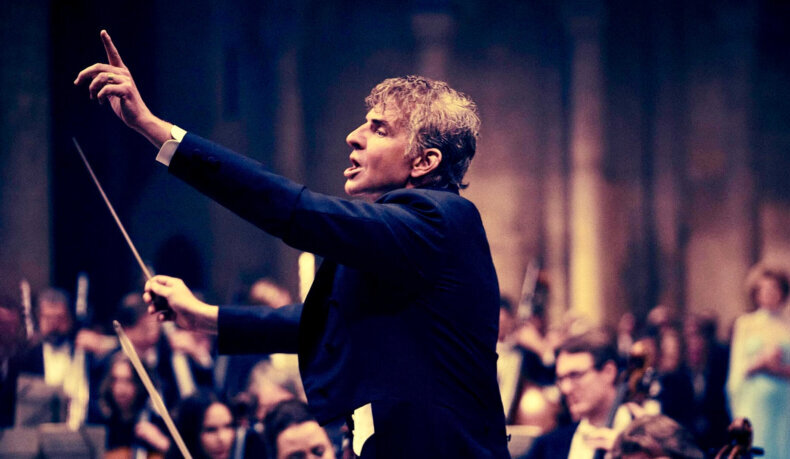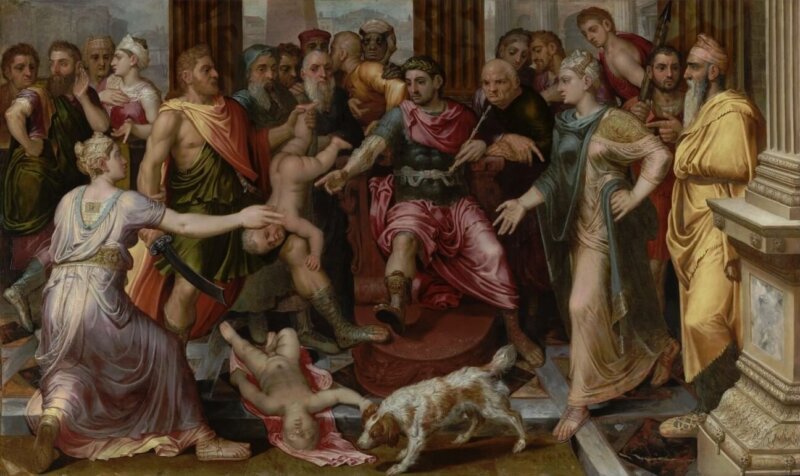“Maestro” and the Misuse of Culture

Writers for the movies, I have found, don’t seem to know how to deal with the arts as a dramatic subject. Perhaps due to a lack genuine knowledge about music or art, writers tend to treat it in a superficial way, as if art consisted merely of a flash of genius or talent, an effusion of emotion instead of what it is in large part, a craft requiring training and hard work.
Another superficiality of screenwriters when dealing with the arts is not to deal with them at all, but to make them a mere backdrop for the personal or psychological crises of the protagonists, which become the real subject of the film. This is the central problem with the new film Maestro, ostensibly a biopic about 20th-century classical musician Leonard Bernstein.
An epigraph, a quote from Bernstein himself, appears onscreen before the start of the movie: “A work of art does not answer questions, it provokes them; and its essential meaning is in the tension between the contradictory answers.” However valid this statement may be about art in general, it certainly applies to the movie we are watching. Maestro provokes many questions about culture and life, perhaps not always the ones the filmmakers had in mind—although one can’t be entirely sure.
The movie begins in 1943, as Leonard Bernstein experiences the event that launches his musical career: he is called up to conduct the New York Philharmonic at last minute, after the regular conductor falls ill. From then on Lenny’s career is continuously on the rise. Bernstein has the kind of personality that fills the room and tends to overwhelm anyone else who happens to be in it. He is also a man of strong passions, of all kinds. He loves people, he tells us; many, in fact. One of them is Felicia Montealegre, the woman he marries and with whom he has three children. We see throughout the movie that he genuinely loves Felicia and that they share a wonderful rapport.
But Bernstein has a problem that gnaws at him and throws his marriage and life off balance. In the words of his sister, Lenny has trouble “being just one thing” (watching the movie, I wondered if here was the opposite of Kierkegaard’s ideal of the man with secure values who can “will one thing”). And this ambivalence applies not only to his busy life in music—where he wears many hats as conductor, teacher, and composer of both classical and Broadway scores, among other roles—but to his sexuality.
Here, then, we have the film’s central conflict and main focus—not the symphonies, the musicals, the Young People’s Concerts, the resurrection of Mahler, or Bernstein’s many other accomplishments in music. And this is where the film stumbles. Because what makes a Leonard Bernstein unique and sets him apart is his art, not his personal sins and infidelities, by virtue of which he resembles millions of poor souls the world over and which, therefore, are uninteresting as the main subject of a movie.
True, Bernstein’s double life, his tragically divided self—happily married yet pursuing homosexual affairs on the side—and how this affected his public life as an artist is definitely of moral and psychological interest. But by putting this conflict front and center and slighting what truly made Bernstein who he was in his core—his musical mind and passion—the filmmakers ultimately lose any reason for making (or watching) the film.
Think of it this way. There are probably thousands of people seeing Maestro who have no idea what exactly a conductor does. Here was an excellent opportunity for the filmmakers to educate the public, just as Bernstein himself did. They could have highlighted how the Young People’s Concerts in the ‘50s and ‘60s used the mass medium of television to instruct children about the glories and intricacies of classical music, helping to keep interest in the art form alive. The Young People’s Concerts get one brief mention in the film. Ditto for West Side Story, probably Bernstein’s greatest claim to fame for the general public; it is mentioned and dropped. Bernstein’s pioneering effort to bridge “classical” and “popular” culture in his Broadway theater pieces has inherent dramatic interest. In this movie ostensibly about a conductor, we see at most maybe six minutes of Bernstein actually conducting an orchestra.
True enough, Bernstein compositions are featured in the soundtrack under various scenes, sometimes quite cleverly. Early on, when Lenny and Felicia are courting, there is a moment when they suddenly become characters in the ballet from On the Town, and a surreal dream/ballet sequence ensues that dramatizes the conflict in their relationship. This kind of art-meets-life angle is something the movie should have developed further. Instead, we are treated to a lot of music-less interviews and dialog as a way to move the plot forward. The art of music, which should be central to the film, recedes into the background in favor of the familiar clichés of career, personality, and neurosis—and lots and lots of cigarette smoking.
And so, the message Maestro inadvertently sends is: art is boring; personal dysfunction and a disordered life are interesting. Conducting symphonies and making one’s way as an artist are things that just sort of happen, like making eggs for breakfast. The real storm and stress of life come in elsewhere. Mostly they have to do with sex. The movie panders to prurient curiosity and undermines serious interest in Bernstein as the cultural leader he was.
Questions, Questions…
Yet true to Bernstein’s adage, Maestro does raise constructive questions. What is the relationship between art and morality? Between morality and intellect? Between intellect and art?
For more than a century now an influential segment of the artistic population has embraced a bohemianism that proclaims art free from the constraints of conventional society and morality. Is this right? Is art a free-for-all, a morally neutral space where we merely express our subjective feelings, or should the artist embody an objective framework of values, both in art and in life?
What is the relationship between art and religious values? Bernstein was Jewish. How did his identity as a Jew relate to the morally problematic aspects of his lifestyle? This is not among the questions the filmmakers are interested in asking. Isn’t Judaism here being reduced to an empty social label, devoid of content? Late in the movie, Bernstein is composing his theater piece Mass and the camera lingers upon the score as he pencils in the word lauda (Latin for “praise”). Is this a spiritual epiphany for Lenny? The movie fails to make anything of it.
Watching Bernstein’s rise and fall in Maestro, I couldn’t help but think of the old Apollonian/Dionysian conflict, memorably described by Nietzsche. Art and life are marked by an interplay between the forces of Apollo (representing reason, law, order, and restraint) and Dionysus (representing wild and irrational instincts and passions). The Bernstein of Maestro bears this conflict in his very soul, as his desire for normal family life is constantly undermined by passions that pull him in the opposite direction.
There has been a widespread divorce of the arts from objective truth and what C.S. Lewis referred to as the Tao, the moral compass. Immoral behavior is seen as chic and “artistic” because a portion of the arts world has embraced a vision of art detached from wisdom, from philosophy and a genuine intellectual life (as opposed to pseudo-intellectualism).
Despite all this, late in the movie Bernstein seems to find reconciliation at a performance of Mahler’s Resurrection Symphony in an English cathedral (a scene which offers the film’s only sustained illustration of what Bernstein did for a living). After the intensely emotional performance, he lovingly and passionately embraces his wife amid the audience’s cheers. The movie should have ended here.
Where does the movie end instead? Felicia is diagnosed and dies from cancer. Bernstein stands by her all the way and is grieved after her death. Yet life moves on. In the film’s final frames, Bernstein has embraced the élan vital and is embarking on yet another homosexual affair, this time with a young conducting student. The final images of Bernstein show a pathetic, aging man desperately grasping for youth, an erstwhile spokesman for high culture whooping it up at a disco.
Speaking to interview cameras toward the end of his own life, Lenny recalls something Felicia told him: “If nothing sings in you, then you can’t make music.” Here, then, is another great question: what should sing in us? True love, or narcissistic self-love? What matters more, the truth or “doing your own thing”? Much earlier, before their marriage and aware of her fiancé’s tendencies, Felicia had told Lenny: “What age are we living in? Today one can be free as one likes without guilt or confession.” How did such freedom turn out?
Maestro left me with a similar feeling to Elvis, the major biopic of last year. Although vastly different in their artistic aims, the pop star and the symphonic conductor are both portrayed as spiraling into self-destruction due to poor choices. But how many times do we need to see this same basic storyline play out? It is a worn-out cliché that offers no new insights. “Tear down the image” and “dig up the dirt” have become stale models for telling a life story.
Wherefore the Biopic?
And thus Maestro, finally, raises questions about the biopic (or film biography) as a genre. We know that the person we are seeing on the screen is not Leonard Bernstein. It is Bradley Cooper playing Leonard Bernstein, speaking lines of a script that may have a close or remote relationship with the truth of the events and people it purports to depict. All biopics are entertainment and embellish the facts to some extent. But how much is fact and how much fiction? To what extent is this the story of a life, and to what extent is the screenwriter using a historical figure as a springboard to tell a story he wants to tell? Let us be clear: without doing extensive research, we really don’t know how true this movie is to the real Leonard Bernstein.
A further question along those lines: why do we need biopics of 20th-century creative figures who are already copiously preserved on film and recordings? If we can watch and listen to the real Bernstein, why settle for a fictive one played by Bradley Cooper?
The answer must be that a film like Maestro allows one to delve into the dark places of an individual’s private life, which was hidden by the seemingly pristine veneer of his career and public image. It offers a chance to psychoanalyze a person who can no longer speak for himself. If the filmmakers’ intention was to shatter illusions and let unpleasant truths be revealed, they succeeded.
Maestro is certainly well-made—there is striking imagery throughout, in both black-and-white and color—and well-acted, with Bradley Cooper (who also directed) carrying off a spot-on impersonation of Bernstein, and Carey Mulligan every bit his match as Felicia. But at its core is an emptiness that no mere artifice can fill. The movie fails to convey the significance of its subject, nor any sense of what a life of culture might mean beyond a projection of the ego. It equates the arts with fame and celebrity, those poisons of the modern world. Instead of taking a redemptive path, it chooses to wallow in the darkness and despair that we know only too well as the background of countless celebrities who let their fame go to their head.
Ultimately, I fear, movies like Maestro offer only ersatz culture, a pseudo-sophistication in which people stand around holding cocktail glasses and saying “artsy” things. Viewers who knew nothing about Bernstein the musician or classical music in general before they walked into the theater will leave Maestro unenlightened.
The End of Cultural History
It is evident that Western culture has reached a state of fullness and completion (or exhaustion and decay, depending on your point of view), one small symptom of which is our subsisting on a fixed repertoire of cultural touchstones from the past, as seen for example in the offerings on the big screen. The present seems paltry and banal compared with the grandeur, heroism, glamor, and world-historical importance of former times. The past had cultural giants who tower over the pygmies of the present. Hence the need to perpetuate on the screen the likes of Winston Churchill, Leonard Bernstein, Audrey Hepburn, J. Robert Oppenheimer, the Barbie doll, or whatever other “icon” (a favorite word) needs to be duplicated in high definition.
The one thing that has continued to develop is technology, so as better to reduplicate everything we’ve already seen. We have tons of information at our fingertips, so that we can stuff screenplays with all kinds of arcane historical detail. Or if we want, we can re-create Bernstein’s performance of Mahler in Ely Cathedral in 1974 (and, somewhat redundantly, we can also view the real thing on YouTube). We can imitate with faithful accuracy the look and feel of every period from the 1940s to the 1980s and beyond, carrying us sensorially back into the past.
In sum, we are surrounded by all the cultural stuff of past ages. What do we do with it? Mere re-creation has little value in itself. You can put a faux Leonard Bernstein up on the screen, and it may be amusing and interesting for a while, but the novelty will wear off unless there is a deeper substance or reason behind it.
Finding that substance is the task of the serious artist and thinker who uses the past to create new art. Artists should avoid falling into the abyss of cheap sensationalism and nihilism, and instead mine the past for the moral lessons, transcendent beauty, and serious values that it has to offer.




